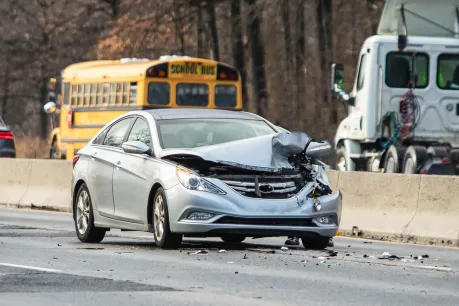Car Accident Statistics and Trends

Injured?
A routine commute or a quick run to the store and suddenly change a life—and leave devastating consequences for those involved.
Car accidents remain a significant issue in the United States, leaving many drivers and passengers to deal with painful injuries, mounting medical bills, vehicle damage, and even the loss of loved ones.
According to the National Highway Traffic Safety Administration (NHTSA), approximately 38,000 people lost their lives in motor vehicle crashes in 2020 alone.
Statistics and trends surrounding car accidents can provide a more comprehensive picture as to just how serious this issue is.
Despite our best efforts, accidents can and do happen—often due to someone else’s negligence. If you or a loved one suffered a car accident that wasn’t your fault, you have options, and you don’t have to face the aftermath alone. Contact Morgan & Morgan for a free case evaluation to learn more about your legal options and the compensation you may be owed. This money can be used to get your life back on track. Call us today.
Top Causes of Car Accidents in the U.S.
Distracted Driving
Distracted driving is one of the leading causes of car accidents in the United States. This includes anything that diverts a driver’s attention from the road, such as texting, talking on the phone, eating, adjusting the radio, or engaging with in-car technology. According to the Centers for Disease Control and Prevention (CDC), in 2019 alone, 9% of all fatal crashes were caused by distracted driving. That’s over 3,000 deaths attributed to this behavior.
The most concerning aspect of distracted driving is its prevalence among younger drivers. The CDC reports that drivers under 20 are most likely to be involved in fatal crashes caused by distracted driving. This group is particularly vulnerable to texting while driving, which is an extremely dangerous form of distraction.
Speeding
Speeding is another major contributor to car accidents in the U.S. Excessive speed not only reduces the amount of time a driver has to react to a hazard, but it also increases the severity of accidents when they do occur. The National Safety Council (NSC) reports that 9,478 people died in speed-related crashes in 2020, which accounted for nearly 26% of all motor vehicle fatalities. Speeding, particularly in areas with dense traffic or complicated intersections, can lead to collisions with more devastating consequences.
Impaired Driving
Impaired driving—whether due to alcohol, drugs, or a combination of substances—remains one of the deadliest causes of car accidents. According to NHTSA, 11,654 people died in alcohol-impaired crashes in 2020, accounting for nearly 30% of all traffic fatalities in the U.S. While alcohol remains the most common impairing substance, drug-related crashes are on the rise, with marijuana and opioids frequently identified as contributing factors.
When combined with the increased popularity of prescription medications and over-the-counter drugs, impaired driving presents a significant public health threat. Impairment can affect judgment, reaction times, and coordination, leading to deadly accidents.
States and Regions With the Highest Car Accident Rates
States With the Highest Rates of Car Accidents
Certain states have higher car accident rates than others, often due to population density, road infrastructure, weather conditions, or local driving behaviors. States like California, Mississippi, Texas, Florida, South Carolina, and Georgia consistently report high traffic accident rates due to their large populations, expansive road networks, and high volume of tourists and residents.
In California, for example, despite efforts to improve road safety, the state recorded nearly 3,500 fatalities from car accidents in 2020 (NHTSA). High population density, urban sprawl, and congestion on major highways all contribute to the state’s elevated crash rate.
Florida is another state with high accident rates. In 2020, Florida reported more than 3,300 fatalities in motor vehicle crashes. Factors like the large number of elderly drivers, tourists, and heavy rainfalls during certain seasons all contribute to the state’s elevated crash statistics.
Contributing Factors to Regional Differences
Regional differences in car accident rates often reflect a combination of environmental factors, local driving cultures, and state traffic laws. States with more urban centers, for example, often experience higher traffic volumes, leading to more accidents. Similarly, weather conditions such as snow and ice in northern states, or heavy rain in southern states like Florida, can increase the frequency of accidents.
Some states have stricter traffic laws, which can help lower accident rates. For instance, states with harsher penalties for drunk driving, texting, or speeding often experience fewer related fatalities. These states often have lower rates of severe accidents compared to states with more lenient laws.
High-Risk Seasons and Holidays for Car Accidents
Holiday Travel
Certain seasons and holidays see an increase in car accidents due to higher traffic volumes and increased risk factors, such as impaired driving or tired drivers. Major holidays like Thanksgiving, Christmas, and New Year’s Day tend to be high-risk periods for accidents. During the holiday season, people often drive long distances to visit family and friends, and alcohol consumption is at its peak.
In 2020, the National Institute on Alcohol Abuse and Alcoholism (NIAAA) reported that 40% of traffic fatalities during the holiday season involved alcohol-impaired drivers. The combination of more drivers on the road and increased alcohol consumption increases the likelihood of accidents.
Summer and Spring Break
The summer months and spring break are also particularly risky for young drivers, many of whom are newly licensed or lack experience driving long distances. Research shows that the highest number of fatal accidents involving teenage drivers occurs during the summer. In fact, between 2014 and 2018, the Insurance Institute for Highway Safety (IIHS) found that summer was the deadliest season for teen driving accidents.
To avoid risks, drivers can take extra precautions during these peak times, such as planning routes in advance, taking breaks to avoid fatigue, and avoiding alcohol or drugs while driving.
The Deadliest Vehicles and Common Types of Car Accidents
Deadliest Vehicle Types
While any vehicle can be involved in a car accident, some types are more likely to result in fatalities due to their design and purpose. According to NHTSA, larger vehicles like SUVs and pickup trucks are more often involved in fatal crashes, primarily due to their higher mass and the greater impact they deliver in collisions. However, they are also less likely to be involved in rollover accidents compared to sedans and smaller cars.
Motorcycles, while not technically cars, are also included in this conversation due to their high fatality rate. In 2020, motorcyclists accounted for nearly 14% of all traffic fatalities, despite making up only 3% of all registered vehicles on the road.
Common Types of Car Accidents
Car accidents vary in type and severity, but some types are more common than others. Some of the most frequent types include:
- Rear-End Collisions: These are often caused by tailgating, distracted driving, or sudden stops. Rear-end collisions are the most common type of accident in the U.S. and typically result in minor injuries.
- T-Bone Accidents: Also known as side-impact collisions, T-bone accidents occur when one vehicle strikes the side of another. These accidents are often more dangerous because the side of a car offers less protection than the front or rear.
- Single-Vehicle Crashes: These crashes often occur when a driver loses control of their vehicle and crashes into a fixed object like a tree, guardrail, or utility pole. Speeding and impaired driving are frequently associated with single-vehicle accidents.
Weather-Related Car Accident Statistics
Impact of Weather on Car Accidents
Weather conditions are a significant factor in car accident rates. Snow, rain, fog, and ice reduce visibility, road traction, and increase stopping distances, all of which can contribute to accidents. According to the Federal Highway Administration (FHWA), weather-related crashes account for nearly 21% of all accidents in the U.S. and 16% of all fatal crashes.
For example, rain is a major contributing factor in accidents, with wet pavement causing 70% of weather-related crashes. Similarly, snow and icy conditions account for a disproportionate number of accidents in northern states during winter months. In fact, data from the IIHS indicates that approximately 1,300 fatalities occur in snow and ice-related accidents each year.
Driving in Adverse Conditions
It’s essential for drivers to adjust their driving behavior when conditions are less than ideal. Some best practices for driving in poor weather include increasing following distance, reducing speed, and turning on headlights in rain or fog.
Understanding the Probability and Risks of Car Accidents
Likelihood of an Accident
While car accidents are common, the probability of being involved in one depends on a variety of factors, including driving behavior, vehicle type, and location. On average, the odds of an American driver being involved in a car crash during their lifetime are 1 in 366, according to the Insurance Information Institute (III).
The odds of being injured or killed in an accident are even more dependent on other factors, such as seatbelt use, alcohol consumption, and the presence of other drivers on the road. For instance, the odds of being killed in a car accident are higher for motorcyclists and pedestrians, compared to passengers in enclosed vehicles.
Preventative Measures and Safety Laws
Safety Laws and Initiatives
To reduce car accident fatalities, various safety laws have been enacted across the country. For example, "Chloe's Law" in Florida requires all vehicles to be equipped with a rear seatbelt reminder system. Additionally, stricter DUI laws, such as the use of ignition interlock devices for convicted drunk drivers, have been proven to lower alcohol-related crashes.
Other laws focus on seatbelt use, distracted driving, and driving under the influence of drugs or alcohol. The NHTSA's national "Click It or Ticket" campaign promotes seatbelt use, while states have implemented "hands-free" laws to prevent texting while driving.
Safe Driving Tips
There are several key practices every driver can follow to reduce the risk of accidents:
- Always wear your seatbelt.
- Avoid using your phone or engaging in other distractions.
- Slow down in bad weather conditions.
- Never drive under the influence of drugs or alcohol.
- Get regular vehicle maintenance and check tire pressure.
In conclusion, while car accidents remain a major issue in the U.S., understanding the causes, trends, and preventative measures can help reduce the risks. By staying informed and following safe driving practices, we can all contribute to making the roads safer for everyone.
Injured in a Car Accident? Morgan & Morgan Can Help
Regardless of how much we understand the statistics and trends of car accidents or how cautiously we navigate the roads, accidents still can and do happen—every day and without warning.
At Morgan & Morgan, we have represented victims of car accidents for over 35 years, helping them to fight for the compensation they need and deserve to move forward with their lives. We have recovered over $23 billion in the process, and you can learn if we may be able to help you too, with a free case evaluation.
You don’t have to bear the burden of someone else’s mistake. Contact us today.
Learn more

We've got your back
Injured?
Not sure what to do next?
We'll guide you through everything you need to know.

